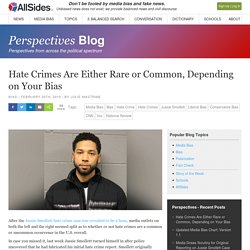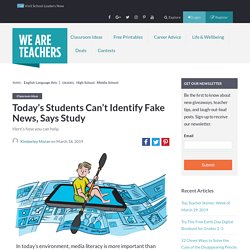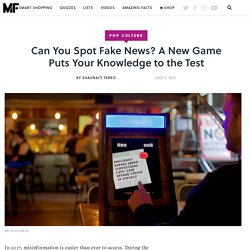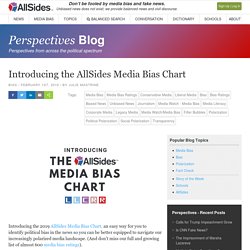

I Failed the Covington Catholic Test. Media Misfires on Covington Catholic Story. Hate Crimes Are Either Rare or Common, Depending on Your Bias. After the Jussie Smollett hate crime case was revealed to be a hoax, media outlets on both the left and the right seemed split as to whether or not hate crimes are a common or uncommon occurrence in the U.S. overall.

In case you missed it, last week Jussie Smollett turned himself in after police uncovered that he had fabricated his initial hate crime report. Smollett originally claimed two men beat him while making racial and homophobic remarks and yelling “This is MAGA country.” Police now believe Smollett, unsatisfied with his salary and seeking publicity, paid two brothers to stage the attack just a week after Smollett wrote himself a threatening letter. Smollett was charged with a felony crime of filing a false police report. The right largely condemned the news media and prominent Democratic politicians for uncritically accepting Smollett’s initial version of events and running with the story before all the facts were out.
What the Right Says About Hate Crimes. Jussie Smollett’s alleged hate crime attack hoax and arrest, explained. How anonymous tweets helped ignite a national controversy over MAGA-hat teens- The Washington Post. Timeline of the Jussie Smollett attack investigation. Rush to judgment in the Jussie Smollett case? SHEG Evaluating Information Online. Untitled. Steps for Evaluating the News - Evaluating News Resources - Research Guides at Rutgers University. Evaluating News Sources - Finding News and News Evaluation - LibGuides at University of Texas at Austin. For Educators — News Literacy Project. 6 Steps to Spot Fake News. Stanford History Education Group: Civic Online Reasoning. FactCheck.org - A Project of The Annenberg Public Policy Center.
NewsFeed Defenders. Factitious - A Game That Tests Your Ability to Spot Fake News. Factitious is a game for testing your skill at identifying fake and misleading news stories. The game was developed by the American University Game Lab and the American University's School of Communication. I learned about the game last month when Larry Ferlazzo featured it and I have since shared it in a couple of professional development workshops. It was a hit in both workshops in which I shared it with teachers. To play Factitious simply go to the site and select quick start.
You'll then see an article appear on the screen. Factitious does offer the option to create an account to save your progress in a game, but you don't need to create an account in order to play the game in "quick start" mode. Applications for EducationFactitious could be a great game to have students play at the conclusion of a larger lesson about evaluating the credibility of websites. NPR: Factitious Game.
News & Media Literacy: 6–8. Websites on Media Literacy and Advertising. Can Your Students Recognize Bias? 7 Tips for Teaching Media Literacy. In today’s environment, media literacy is more important than ever.

But the sparse research on the topic shows us that kids really struggle with identifying legitimate sources. This Stanford study found that 82 percent of middle school students couldn’t distinguish between a news story and one labeled as sponsored content. Another 80 percent assumed that an unsourced photo was proof of a misleading claim. So how can teachers help? The following ideas can help students learn to recognize bias and evaluate their sources more carefully. 1. Put your students in groups and ask them to discuss the following questions: What is fake news?
Just because the terms “fake news” and “news bias” are all over the news media doesn’t mean that your students know what they mean or why they matter. 2. Show your students the website All About Explorers: Christopher Columbus and ask them to locate information about him. 3. How do you know when a source is reliable? 4. 5. Can You Spot Fake News? A New Game Puts Your Knowledge to the Test. In 2017, misinformation is easier than ever to access.

During the 2016 election, scammers—including hordes of Macedonian teens—raked in serious money by churning out deliberately fake stories about U.S. politics, with a very real impact. In a December 2016 Pew Research Center survey, 64 percent of U.S. adults said that fabricated news was sowing "a great deal of confusion" about current events. Quiz: Can You Tell Real News Headlines from Fake? Fake news websites derive nearly 42 percent of their traffic from social media platforms, with readers clicking links they see posted on Twitter, Facebook, Instagram and other social sites.
But those links offer only headlines, making it difficult for even educated news consumers to know if what they’re seeing is real or fake news. To test your ability to tell real news from fake from headlines alone, we’ve crafted a quiz that will test your media smarts and skills at spotting fake news. How’d you do on the quiz? However you scored, you’ll want to read the tips we’ve compiled with help from journalists to make sure you don’t fall prey to fake news in the future. AllSides Media Bias Chart. Introducing the 2019 AllSides Media Bias Chart, an easy way for you to identify political bias in the news so you can be better equipped to navigate our increasingly polarized media landscape.

(And don't miss our full and growing list of almost 600 media bias ratings). Click here to share the media bias chart on Facebook. Mind Over Media. Media Education Documentary Films and Educational Resources. Media Literacy Now – Advocating for Media Literacy Education. Balanced news via media bias ratings for an unbiased news perspective.